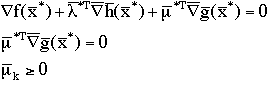minimize f(x)
![]() (n variables in x)
(n variables in x)
subject to h(x)=0 (m equality constraints)
g(x) <= 0 (p inequality constraints)
General Form
minimize f(x)
(n variables in x)
subject to h(x)=0 (m equality constraints)
g(x) <= 0 (p inequality constraints)
Monotonicity analysis can be useful in determining the constraints that comprise the optimal active constraint set. If we know the optimal active constraints set, we can use the Courant heuristic in which we ignore the inequality constraints not in the active set and treat the active constraints as equalities. We are left with an optimization problem subject to equality constraints and can use the Lagrangian technique previously discussed.
What is the activity of some of the inequality constraints cannot be determined? Several approaches will be discussed.
Kurush Kuhn Tucker Conditions
Historical Perspective
Vanderplaats, published in 1984, calles them the Kuhn-Tucker conditions. Papalambros and Wilde, published in 1988, refers to the KKT conditions.
The Lagragian:
First order conditions:

The last two equations are known as the complementary slackness conditions.
Example
min f(x)= 2x12+2x1x2+ x22 -10x1-10x2
subject to x12+ x22 <= 5
3x1+ x2 <= 6
The Lagrangian:
First order conditions:
There are no obvious monotonicities. Assume the constraints are inactive.
Assume constraint 1 is active, constraint 2 still inactive.